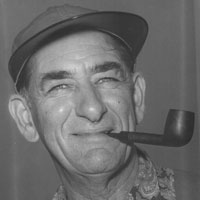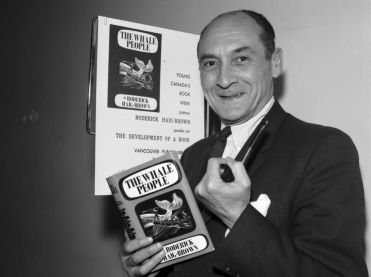Roderick Langmere Haig-Brown was a Canadian writer and conservationist.
Haig-Brown was born in Lancing, Sussex, England. His father, Alan Haig-Brown, was a teacher and a prolific writer, the author of hundreds of articles and poems on sports, the military, and educational issues in various periodicals. Alan was also an officer in the British Army during World War I. In 1918 he was killed in action in France.
Roderick's mother, Violet Mary Pope, was one of fifteen children of Alfred Pope, a wealthy Dorset brewer. After the war ended Roderick, his mother and his two sisters went to live with her family. His grandfather Pope was an industrious man with very strong Victorian values of “service, fair play, decency and acceptance of the obligations that follow with the privilege of class and education.”
His grandfather was a friend of Thomas Hardy and took young Roderick to tea there on at least one occasion. Roderick later noted in his essay “Hardy’s Dorset” that he regretted not having elicited more information from Hardy about being a writer, but he was sixteen then and was passionate about fishing and shooting. Life on his grandfather's country estate on the Frome River was fascinating to him. His many uncles loved sport and taught him to fish and shoot, but it was a family friend, Major Greenhill, who served as Roderick’s sporting mentor and taught him both the skills and the ethics of sportsmanship. The estate's gamekeepers introduced him to the importance of conservation and the complexity of the environment. In 1921 Roderick entered Charterhouse where his grandfather Haig-Brown had been headmaster.
His physical and social childhood environment contributed, according to biographer Anthony Robertson, to Roderick’s code of conduct. Throughout his life he adhered to an ideal balanced between reason and passion, an ideal infused with knowledge and tempered by responsibility, decency and fair play. This code “invoked a mental and physical discipline that went beyond making a successful catch or kill; its central virtue was knowledge, intimate and thorough, transcending pursuit.”
Haig-Brown found his way to British Columbia, Canada through a series of unexpected events. After he was expelled from Charterhouse School, he joined his father’s regiment for a short while, but found that army life was too restrictive. The family decided that the British Colonial Civil Service might be a more agreeable alternative, but he was too young to write the exams. He went, in the meantime to Seattle, Washington at the invitation of an uncle who had married a Seattle woman, promising his mother he would come back when he was eligible for the civil service. He worked at a logging camp in Washington, then crossed the border to Canada because his U.S. visa had expired. He remained in British Columbia for three years to work at Nimpkish Lake on Vancouver Island as a logger, a commercial fisherman and an occasional guide to visiting anglers. He returned to England in 1931 and enjoyed the fast-paced life of London. But images of British Columbia haunted him while he wrote his first book, Silver: The Life of an Atlantic Salmon (1931) as well as part of Pool and Rapid (1932). He returned to BC at the end of the year and planned his third book, Panther (1934).
He married Ann Elmore of Seattle after publishing Panther, and the couple settled on the banks of the Campbell River where they lived for the rest of their lives, raising three daughters and a son.
From the year of his return to British Columbia to 1976, the year of his death, Roderick Haig-Brown published twenty-three books (five more were published posthumously), wrote numerous articles and essays, and created several series of talks and historical dramas for the Canadian Broadcasting Corporation. He is most famous internationally for his writing on fly fishing and the natural world.
He joined the Canadian Army as a personnel officer in 1943 and was later seconded for several months to the Royal Canadian Mounted Police which allowed him to travel across Canada and to the Arctic. He was magistrate for the town of Campbell River from 1941 until 1974. He became a trustee of the Nature Conservancy of Canada, an advisor to the BC Wildlife Federation, a senior advisor to Trout Unlimited and the Federation of Flyfishers, and a member of the Federal Fisheries Development Council and the International Pacific Salmon Fisheries Commission. He was also Chancellor of University of Victoria from 1970 to 1973. He served three times on the Federal Electoral Boundaries Commission for British Columbia. These many responsibilities prevented him from devoting much time to writing. He retired from the bench a year before his death and was planning to get back to writing as the pressure of his other commitments gradually eased off. His life in his mature years were featured in many of his books, especially "A River Never Sleeps" and "Measure of the Year."
R.L. Haig-Brown died on October 9, 1976 at the age of 68.




